With Norfolk’s Rebellion Way, Cycling UK have created yet another excellent route. But in linking this multi-day ride primarily to the history of ‘rebellion’, they have given us a feisty heroine (Boudica), but overlooked – to some extent at least – the elephant in the room. Actually, it’s not an elephant, but sheep, millions of them, and the wool trade that drove wealth, commerce, politics, and war in Mediaeval England. And Norfolk was at the heart of this.
This 375 kilometre circular route is badged the ‘Rebellion Way’ on account of Norfolk (along with Suffolk and parts of Cambridgeshire) once being home to the Iceni, whose legendary Queen Boudica led an uprising against Roman rule in AD 61. There are remnants of their world to be seen on the route, mainly to the south of Norwich at the settlement known as Venta Icenorum. But it is the legacy of the vast wool trade that developed one thousand years later that provides the thread weaving together the landscape of towns and villages, churches, mansions, ports, and much else that provides the most prominent backdrop for this ride.
The story of wool in Mediaeval England
I was not surprised to learn that nowadays shearing a sheep costs more than can be recouped from selling the wool, and farmers are increasingly turning to breeds that shed their wool. And of course, much of the wool that is shorn goes to waste, or ends up as insulation, compost, etc.
So, it is remarkable that for several hundred years from the late 13th Century, wool was the foundation of wealth in England. Just about everyone with land, peasant or landowner, kept sheep. By 1290, it is estimated there were some 5 million sheep in the country. While some of the wool was used for making cloth locally, vast quantities were exported to Europe for the expert weavers of Bruges, Ghent, and Ypres. Edward I (reign: 1272 – 1307) was the first English king to spot the opportunity for filling the royal coffers with a tax on each exported sack of wool. What’s more, in order to protect these interests, he ordered extermination of all wolves in England. During Henry V’s reign (1413 – 1422) almost two-thirds of the crown’s income came from taxing wool.

Just about everyone with any land kept sheep in Mediaeval England
During the 14th Century, French control of the Flemish weaving towns threatened the valuable wool trade with England and associated tax revenue. This was one factor that led Edward III (reign: 1327 – 1377) to take his country into the Hundred Years War with France (1337 – 1453). But ultimately, high taxation damaged the export trade. More of the wool was kept back and used to weave cloth in England.
Rather in the way that the protestant Huguenots fleeing religious persecution in the late 17th Century brought their silk weaving skills to London, so too did Flemish wool weavers bring their expertise in the 15th Century as they escaped war and French domination. Many came to Norfolk and Suffolk, helping to build a vibrant weaving industry.
Much of the wealth created through wool in mediaeval England remains visible today in the great cathedrals, the many thousands of churches, manor houses, guildhalls, and much else. The Rebellion Way takes you through a landscape rich in this legacy of a commodity that was once ‘the jewel in the realm’, yet has almost no value in our contemporary world.
A snapshot of the Rebellion Way route
Having ridden the wonderfully varied and historically fascinating King Alfred’s Way last year (Part 1 and Part 2), we were very excited to set out on Rebellion Way. Being circular, the route can be started anywhere, although Cycling UK’s guidebook kicks off the route description in Norwich. Keeping to the exact full route will clock up around 375 kilometres (there is a shorter version cutting off the southern section), but exploratory deviations, and starting somewhere off-piste (as we did), will soon push the total over 400 kilometres.

Full route for Cycling UK’s Rebellion Way
The guidebook is very good. It is crammed with fascinating information on the landscape, history, villages and towns, castles, churches, and many other places of interest. Several itineraries of between two and five nights are proposed, along with overview maps by section. Some sections (but somewhat inexplicably, not all) of the route are covered by 1:50,000 OS maps reproduced towards the end of the guidebook. This blog (Part A) covers the western section from mid-way between Diss and Thetford, round via King’s Lynn to the village of Little Walsingham, which lies just to the north of Fakenham on the map above.
The guidebook’s authorship rather likes to give the impression that this is an easy ride and more or less flat much of the way. While Norfolk is far from being mountainous, it is quite hilly in many parts, and older riders like us (aged 67 and 68 years), each carrying 10-12 kg of kit for overnight stays in pubs, etc., will feel this. Depending on age and fitness, you do need to take the terrain into account, given the distances that need to be covered each day. You also need to allow sufficient time to visit the wealth of amazing places along the way; more on this later!
Day 1: A great forest, Siberian Huskies, and Desert Rats; Walsham-le-Willows to Swaffham

Thelnetham windmill, restored and in working order
With the option of starting and finishing our ride with family living close to the Norfolk border at Walsham-le-Willows, we added around 35 kilometres to our trip. We joined the official route between Diss and Thetford at Thelnetham. A short diversion to admire the fabulous early 19th Century windmill (restored to working order in the 1980s), was soon followed by the discovery of hedgerows thick with the most delicious blackberries.
These spontaneous moments are among the delights of cycle touring, but racking up unplanned stops and diversions soon eats into the day’s itinerary. And that creates time pressure when, like us, you have destinations booked. Maybe it would be better not to have a fixed schedule, and hope for the best with accommodation?

Luscious blackberries on the way out of Hopton
The Rebellion Way follows a mix of quiet lanes and bridleways, and our first off-road section was at West Harling Heath, a taster of what lay ahead in the vast Thetford Forest.
At Croxton, on the way north out of the town of Thetford, we found our first round-towered church, one of many we would see over the next five days. In a part of the country that lacked good stone for building, the round construction seems to have been better suited to building with the plentiful ‘knapped’ flint. In fact, of England’s 180 churches with round towers, Norfolk is home to 124 of them, so they are very much a feature of the ride.
The route then took us into Thetford Forest, described as the ‘UK’s largest manmade lowland forest’. The trail was mainly along gravel tracks that would soon bring us to the prehistoric flint mines of Grimes Graves. I was really looking forward to visiting this site where you can descend some 9 metres (30 feet) into the 5,000 year old excavations.
But, rounding a corner, we saw that it was closed for renovation. Gutted! We we did not have time for a thorough visit anyway, so I chalked this one up as the first of what would soon become a substantial ‘Return Visit List’ (RVL).
Deep into the forest we passed the home of the Forstal Siberian Huskies, then rode through Forestry England’s Lynford Arboretum, with its many and varied tree species. Here, we enjoyed excellent coffee and cake at the ‘Shepherd’s Baa’ café; there’s little in the way of shops or refreshment stops en route through Thetford Forest, so this watering hole is not to miss. Next up was the memorial to the WW2 Desert Rats, marked by a Cromwell tank placed on a plinth where you cross the A1065, and a history trail. This part of the forest is also where the early British tanks developed in the First World War were tested.
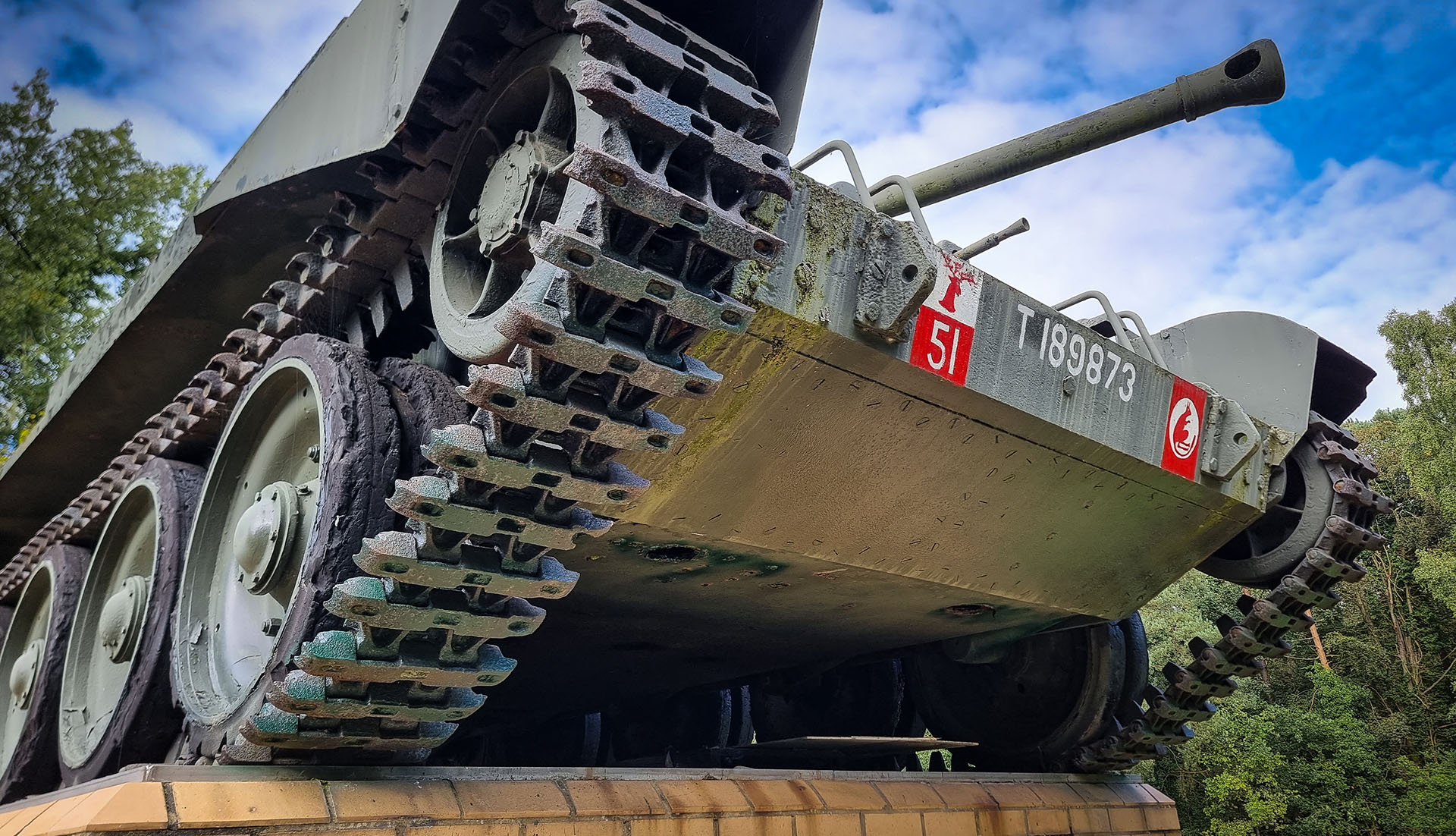
A WW2 Cromwell tank, at the Desert Rats memorial, Thetford Forest
I was starting to feel that you can have a bit too much forest, along with those loose gravel tracks that suck in your tyres and make for heavy going. Emerging eventually from Coldharbour Wood, we still had a way to go before the night’s booked staging post at Swaffham. En route we passed through Oxborough, and (as it was already after 5 pm) could only manage a quick look at the gardens and exterior of the fabulous Oxborough Hall. Now managed by the National Trust, this late 15th Century Tudor mansion was home to the influential court-connected Bedingfield family for 500 years, although their firmly-held Catholic faith resulted in wildly fluctuating fortunes with successive monarchs. Another gem glimpsed, and added to the ‘RVL’.

Oxborough Hall
Nearby, on the village green, is the striking, part-ruined church of St John, intriguing enough for us to get off the bikes again. Once one of the largest churches in Norfolk with a 45 metre (150 foot) spire, the tower collapsed in a storm in 1948, an event that no doubt created some extraordinary and enduring memories for the school children in the playground opposite (no-one was hurt). Fortunately, some important artefacts survived, including the very fine 16th Century terracotta Bedingfield monuments.
And so to Swaffham, passing the wonderfully named Snail Spit Farm en route, and arriving pretty exhausted and much later than planned.
Day 2: Of abbeys, castles and palaces, and the Hanseatic League; Swaffham to Heacham
Heading out of Swaffham, we were soon onto a wonderful rural bridleway where the sandy soil had me sliding around drunkenly on my 35 mm gravel/road tyres. Approaching Castle Acre on a small lane, a ford beckoned, but it was bottom-bracket deep and the river bed loose and stony. There are quite a few fords on the Rebellion Way, and it was a matter of pride to ride through some, at least. But this was too soon to get wet feet, and there were too many people watching …
There’s so much to see at Castle Acre! First, the vast, sprawling ruins of the Clunian Priory (Historic England, entrance fee payable), established in the late 11th Century by the powerful de Warenne family. It was early enough in the day for us to throw caution to the wind, and devote an hour or so to visiting the site. Particularly impressive were the ornate west end of what had been the church, and the Prior’s accommodation that served as a farmhouse in the years following Henry VIII’s demolition of the monastery.

The ornate west facade of Castle Acre Priory church

An illustration of how the fort of Castle Acre may have looked in the Middle Ages
Castle Acre village is very pretty, and coffee and cake beckoned as we passed Wittles café. The castle site is also very impressive (free to enter), not so much for the remains (which are fairly limited) but certainly for its history and the vast defensive earth banks. The castle was built from about 1070 by William de Warenne who inherited the lands through his wife Gundrada, daughter of a Flemish family ennobled by William the Conqueror. It was now late morning, and we had covered barely ten out of a total of 75 kilometres we needed to ride to reach our accommodation at Heacham. Leaving Castle Acre along the Peddars Way, which took every hill straight on as it ran north in true Roman road-engineering style, we then turned west.
Passing another lovely round-towered church at Gayton Thorpe (easy to miss, as it is tucked away a couple of hundred metres to the south of the route), we reached a section of very sandy bridleway near Bawsey. Again, my 35 mm 700C tyres made for quite a challenge, while my wife Jacq found it much easier on her hardtail mountain bike with 2.3 inch 650B tyres. Overall, however, a gravel type bike set-up is the best option for the whole ride, as at least two-thirds is on tarmac.

The round-tower church of Gayton Thorpe, one of the 124 (out of the England’s 180) such churches in Norfolk
The infernal noise of jet-ski racing on the lakes in Bawsey Country Park drove us onwards to find a quiet picnic spot. This we found at the ruined church of St James, standing forlornly on a hillock. Once the centre of a thriving community, it stood witness to how a commercially astute (aka ‘greedy’) landowner in the 16th Century destroyed the village to create more – you guessed it – grazing for sheep. The roads to mediaeval riches were paved with wool.

Remains of St Mary’s Church, near Bawsey
Approaching King’s Lynn, we were very impressed by the extensive network of cycle paths that took us right into the centre of the town and down to the South Harbour beside the Great Ouse, and another café stop. The town, with its once busy port, became wealthy during the Mediaeval Period as a member of the Hanseatic League, which was …
The old centre of the town is fascinating. We passed a statue to local-born Admiral Vancouver who charted the Pacific coast, and managed quick views of the ornate Guildhall and the Minster, the latter with its remarkable mariner’s clock on the south tower visible from the quay. But there was no time to learn more about west Norfolk in the Lynn Museum, or to discover the social history of the town at the True’s Yard Fisherfolk Museum.

The harbour King’s Lynn, on the Great Ouse

An illustration of the fortified site of Castle Rising in the Middle Ages
We left the town via more excellent and well-signposted cycle paths, to reach Castle Rising (Historic England, entrance fee payable), another very pretty village and an impressive mediaeval site with a compelling history. The castle, with its large, ornate stone keep and defensive ditches, dates from the mid-12th Century. During the 14th Century, it was the home of Queen Isabella, the widow of Edward II who is believed to have played a part in his murder. It then passed to the wealthy and influential Howard family who still own it.
After taking a quick look across the drawbridge towards the great keep and then cycling longingly past a very enticing café, we hurried (as best we could) onwards in the still warm, late afternoon sunshine towards Sandringham. Pleasant cycling through the wooded estate brought us to the house, or at least the gatehouse, as the royal residence is well shielded by the gardens. I was disappointed not to even get a view, but the house can be visited. It was only Day 2, and my RVL was already into double figures.
Passing the delightfully aromatic Norfolk Lavender centre, we reached our destination of Heacham where we were treated to one of the gorgeous sunsets for which the town is renowned. Much amusement derived from the large group of golfers staying at our hotel; they hailed from Billericay, were soon well-oiled, and in good form.
Day 3: St Edmund and the wolf, eye-watering wealth, and birthplace of a legend; from Heacham to Walsingham

Old Hunstanton lighthouse, viewed from the ruins of St Edmund’s chapel
Leaving the hotel, we soon found ourselves among the beach huts of Heacham, and the seaside entertainments of Hunstanton. Not quite what I’d expected on a rural bike-packing trip, but I guess it’s all part of the Norfolk story. And there are always things of interest …
Beside the old lighthouse at Hunstanton we found the remains of a chapel dedicated to St Edmund, the King of East Anglia from 855, who was killed in 869 by invading Danes and became a martyr. A wolf sculpture beside the Chapel reminded us of how this animal led the slain king’s people to the place where his assassins had buried Edmund’s severed head. Miraculously, the Saint’s head was then re-joined to his body.
Nearby is a bench honouring Edith Cavell, the First World War nurse born in Norwich and shot in October 1915 by the Germans for helping Allied soldiers escape from Belgium despite international pleas to spare her.

Tea Room and Cafe in Burnham Market
From the pretty, well-to-do village of Ringstead, we took a road that headed due east towards Burnham Market. Almost straight, and like the Peddars Way taking the hills full on, we thought it must be Roman. Maybe it was, but the OS map gave nothing away. The hedgerows were once again thick with perfect blackberries, so while our progress was halting, we kept our energy levels topped up.

Burnham Overy Staithe Windmill
Under a perfect blue sky and with temperatures now well into the 30s, we reached the picture-postcard village of Burnham Market. You just have to stop for lunch here, it would be rude not to.
A diversion of a couple of kilometres then took us past a Carmelite Friary and on to Burnham Overy Staithe Windmill. This stunningly beautiful mill was restored some years ago and is now a private holiday let.
And the interest keeps coming. Soon after, we made another short diversion to see Admiral Lord Nelson’s birthplace at the now-vanished parsonage of Burnham Thorpe. After a few more kilometres, and quite a lot more juicy-perfect blackberries, we reached the southern gatehouse of Holkham Hall.
Turning in, we began our stately progress along the dead straight, two mile long ‘drive’. The estate is truly vast, and I wondered just how anyone could have amassed such wealth?

Holkham Hall – the 2-mile drive leading from the south gate towards the house and lake
Holkham belongs to the Coke family, who hold the title of the Earl of Leicester. The first owner was a lawyer (we’ll meet another rich mediaeval lawyer at Baconsthorpe Castle on Day 4), then marriage into money, agriculture (including reforms and innovations), were among the factors that allowed the family to build the vast ‘European Grand Tour‘ inspired Palladian Hall, and secure their wealth.
There’s much to see and learn about here, in the house and kitchen garden (NT), and in the way the estate is managed now on sustainable principles. I’d say at least half a day is needed here! And, yes, we could do no more than enjoy a picnic lunch by the lake, admire the sprawling mansion, and peer into the gardens.
Leaving by the north gates, a loop through Holkham Pines Nature Reserve close to the sea brought us round to Wells-next-the-sea. This once a busy textile port remains an active centre for shell fishing.
Turning south, we crossed the Wells and Walsingham narrow gauge line, and by now parched in the 32-degree heat, rapidly downed pints of soda and lime at the Three Horseshoes in the village of Warham. This very pleasant pub has accommodation, and was one of those I’d love to return to – maybe as a base to start working through the ‘RVL’.

The Palladian-style mansion of Holkham Hall

A pilgrimage-inspired shop in the village of Little Walsingham
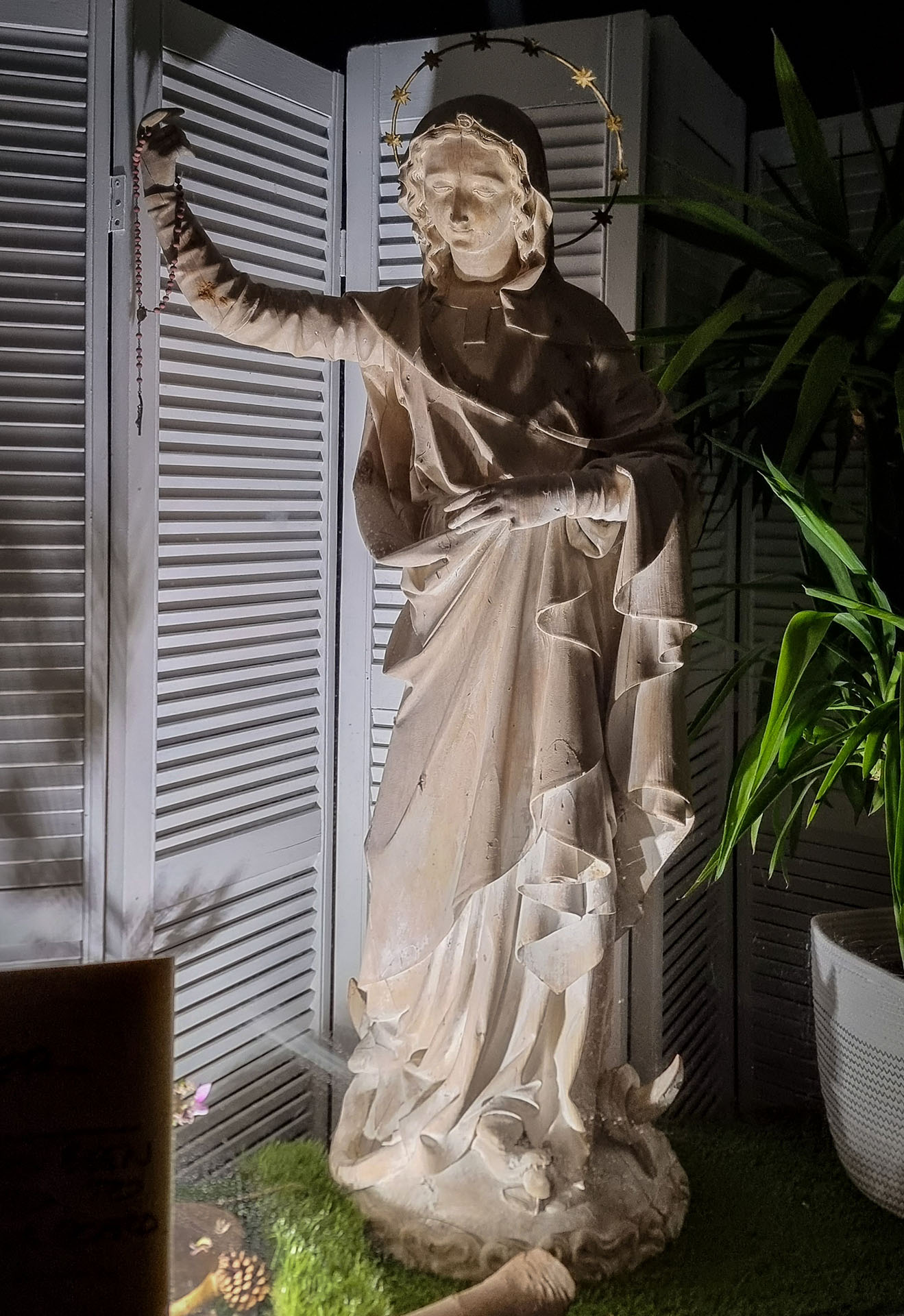
Little Walsingham is one of the most important pilgrimage sites in the UK
A few rolling (quite hilly) kilometres further south, including riding through a ford (my first, though it was shallow), we finally reached Little Walsingham. This pretty, on first sight unassuming, village is in fact the second most important place of pilgrimage in the UK after Canterbury. A recently established 290 km pilgrimage ‘camino’ runs from St Magnus the Martyr Church alongside London Bridge, out of the city along the Lea Valley and on paths and quiet lanes through Essex, Cambridgeshire, Suffolk and Norfolk. Over breakast, we would find out more from our B&B hosts about how the village came to be so revered, before setting off to visit the holy site.
Here is Part B (Days 4 to 6), describing the rest of our ride around the Rebellion Way.
Authors note on posting this blog in two parts
There is just so much of interest on this ride, both in terms of what there is to discover as well as the experience of the cycling, that I have opted (as with King Alfred’s Way) to write up my blog in more than one part. That way, neither part is too long. But I’d be interested to hear whether readers feel about this approach, as opposed to posting one long article.
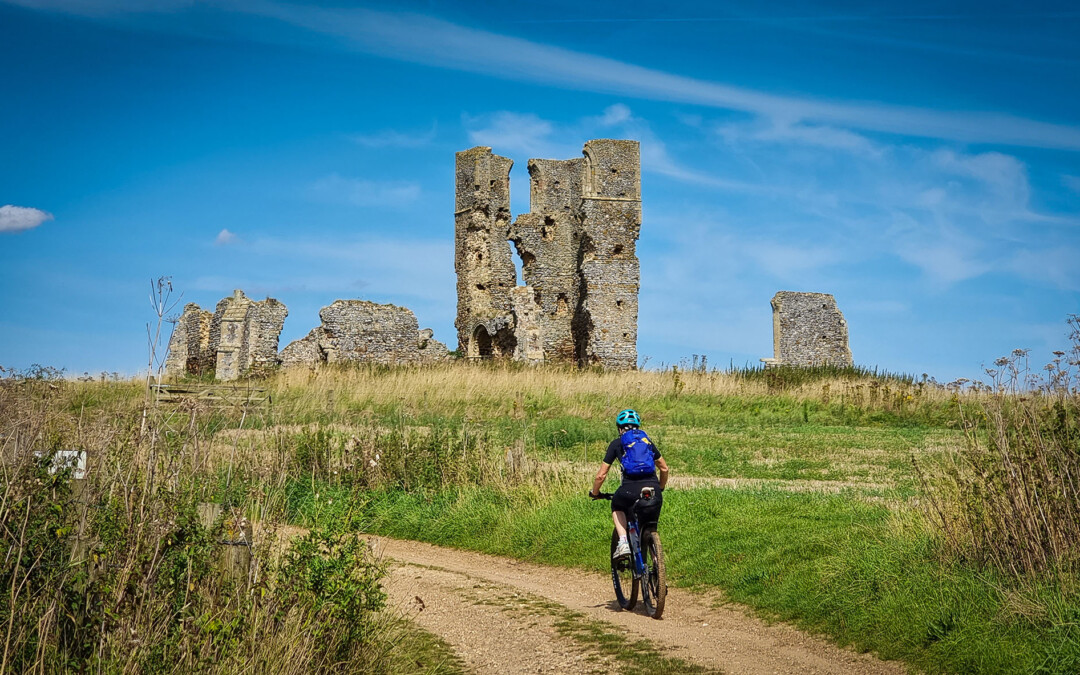


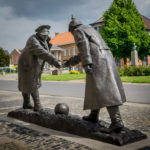
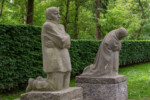

Great blog. We will be cycling the Rebellion Way in April next year and as a history lover I’m really looking forwards to it.
Thanks very much! I’m sure you will love it – though (as I’ve been saying) give yourself plenty of time as you like history and visiting places. I’ll post Part B (Days 4-6) in a few days time.